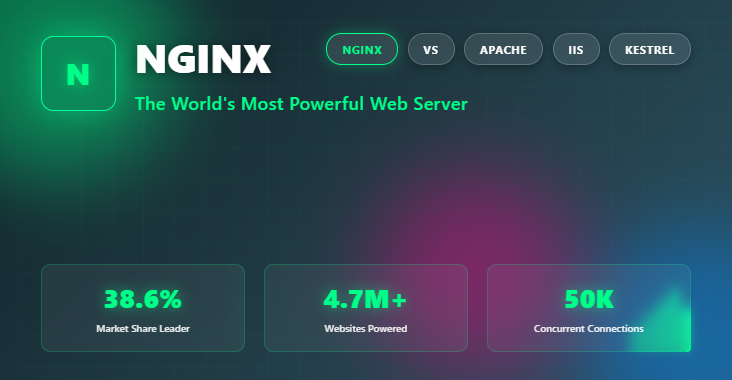When you visit your favorite websites—whether it’s Netflix, Dropbox, WordPress.com, or even NASA—there’s a silent workhorse behind the scenes making everything run smoothly. That workhorse is NGINX (pronounced “engine-X”), and if you haven’t heard of it yet, you’re about to discover why it’s revolutionizing web server technology.
The Incredible Rise of NGINX: From 3.7% to Market Leader
Let me share something that might surprise you. Back in 2009, NGINX held just 3.7% of the web server market share. Apache dominated with over 73%, and Microsoft IIS controlled around 20%. Fast forward to 2025, and the landscape has completely transformed.
Today, NGINX commands an impressive 38.6% market share, serving over 4.7 million websites globally. It has officially dethroned Apache as the world’s number one web server. Even more remarkable? NGINX powers 47.1% of the top 1,000 busiest websites and 44.6% of the top 10,000 sites on the internet.
But here’s the kicker—these numbers don’t even tell the full story. Remember GitHub Pages? Until around 2015, it hosted over 2 million websites on just 2 servers using a multi-million-line nginx.conf file that was edited and reloaded per deployment. This setup worked incredibly well, with github.io ranking as the 140th most visited domain on the web at that time. That’s the kind of raw power and efficiency we’re talking about.
Why Was NGINX Created? Solving the C10K Problem
The story of NGINX begins in 2001 with a Russian developer named Igor Sysoev who faced a serious challenge at work. His web servers couldn’t keep up with the ever-increasing number of requests. The tech community called this the “C10K problem”—the challenge of handling 10,000 simultaneous client connections.
Igor didn’t just patch the problem. He reimagined the entire architecture. Inspired by the design principles of Unix and distributed systems, he developed an event-driven architecture that was lightweight, scalable, and incredibly powerful. That architecture still powers NGINX today, nearly a quarter-century later.
NGINX vs Apache vs IIS vs Kestrel: The Ultimate Comparison
Let’s break down how NGINX stacks up against its main competitors. If you’re deciding which web server to use for your project, this comparison will save you countless hours of research.
Architecture: The Game-Changing Difference
NGINX uses an asynchronous, event-driven architecture. Instead of creating new processes for each web request, NGINX handles requests in a single thread using an event loop. This design allows NGINX to manage thousands of concurrent connections with minimal memory overhead.
Apache follows a process-based model where each simultaneous connection requires a separate thread. While this offers stability and compatibility with legacy systems, it incurs significant overhead under heavy traffic. Think of Apache as feature-rich (like Microsoft Word) where most users only use 10% of available features.
Microsoft IIS is optimized specifically for Windows environments and performs well there, but it’s locked into the Windows ecosystem. It offers tight integration with other Microsoft services like Active Directory and the .NET framework, making it ideal for organizations heavily invested in Windows infrastructure.
Kestrel is Microsoft’s lightweight, cross-platform web server designed specifically for ASP.NET Core applications. While it’s fast and efficient for .NET workloads, it’s typically deployed behind a reverse proxy like NGINX or Apache for production environments because it lacks advanced features like SSL termination, load balancing, and comprehensive security hardening.
Performance: The Speed Test Results
When it comes to raw performance, NGINX consistently outperforms its competitors in handling concurrent connections. Here’s what makes NGINX so fast:
NGINX can theoretically handle up to 50,000 concurrent connections on a single node. In real-world production environments with proper hardware, NGINX easily manages 10,000+ concurrent users per second.
Apache, while reliable, is held back by its process-based architecture and feature bloat. Each connection requires significant memory, making it slower under heavy load.
IIS performs well in Windows environments but generally can’t match NGINX’s efficiency in high-concurrency scenarios. It’s also significantly slower than NGINX when serving static files.
Kestrel is optimized for application-level performance with .NET Core but requires a reverse proxy like NGINX in front of it for production deployments. Kestrel handles application logic brilliantly, but NGINX handles the network-level tasks that would slow down application servers.
Market Share and Adoption Trends
The numbers speak for themselves. As of 2025, NGINX leads with 38.6% market share, Apache follows with around 27.6%, Cloudflare Server (which is derived from NGINX) holds 18.7%, and Microsoft IIS accounts for approximately 11.3% of the market.
The trend is clear: NGINX is gaining ground rapidly, primarily at the expense of Apache and IIS. Companies worldwide are migrating to NGINX for its superior performance and efficiency.
Configuration and Ease of Use
NGINX uses simple, text-based configuration files that are easy to understand and require less memory than Apache’s complex configurations. The learning curve is gentle, and the configuration syntax is intuitive once you get the hang of it.
Apache has a complex configuration system using Apache Configuration Language or XML-based formats. It offers extensive flexibility but can overwhelm beginners. The sheer number of options and directives makes Apache configuration a specialist skill.
IIS provides a graphical user interface for configuration, making it more accessible for administrators who prefer visual interfaces. If you’re already in the Windows ecosystem, IIS feels natural and familiar.
Kestrel offers simpler configuration options, often integrated within ASP.NET Core projects. However, for production deployments, you’ll need to configure a reverse proxy anyway, adding another layer of complexity.
Platform Compatibility
NGINX and Apache are cross-platform champions, running smoothly on Linux, Windows, macOS, and BSD variants. Kestrel also runs on all major operating systems.
IIS, however, is exclusively tied to Windows Server environments. This limitation can be a dealbreaker for organizations using diverse operating systems.
Use Cases: When to Choose Which Server
Choose NGINX when you need:
- Maximum performance for high-traffic websites
- Excellent load balancing and reverse proxy capabilities
- Efficient handling of static content
- Minimal resource consumption
- Modern, scalable architecture
Choose Apache when you need:
- Maximum flexibility and customization
- Strong .htaccess support
- Compatibility with legacy applications
- Extensive module ecosystem
- Shared hosting environments
Choose IIS when you have:
- Windows-based infrastructure
- .NET applications requiring deep Windows integration
- Active Directory authentication requirements
- Microsoft-centric technology stack
Choose Kestrel when you’re:
- Building ASP.NET Core applications
- Working in microservices architectures
- Need lightweight application servers (with NGINX/Apache as reverse proxy)
The Superpowers of NGINX: Beyond Just Web Serving
What makes NGINX truly exceptional isn’t just that it serves web pages faster. It’s the versatility and power it brings to modern web architectures.
1. Reverse Proxy Excellence
NGINX excels as a reverse proxy, sitting between clients and backend servers. It accepts client requests, forwards them to the appropriate server, and returns the response. This setup provides several benefits:
- Hides backend infrastructure from external users
- Centralizes SSL/TLS termination
- Enables seamless scaling and server management
- Adds an extra security layer
2. Load Balancing Made Simple
NGINX includes built-in load balancing capabilities that distribute traffic across multiple backend servers. It supports several load balancing methods:
- Round Robin (default): Distributes requests evenly across servers
- Least Connections: Sends requests to servers with the fewest active connections
- IP Hash: Routes requests from the same client to the same server (sticky sessions)
- Weighted Load Balancing: Assigns different capacities to different servers
This functionality eliminates single points of failure and dramatically improves reliability.
3. SSL/TLS Termination and Optimization
SSL/TLS encryption is crucial for security but CPU-intensive. NGINX can handle SSL termination, freeing backend servers from the computational burden of encryption and decryption. This centralized approach:
- Reduces backend server load
- Simplifies certificate management
- Improves overall application performance
4. Caching and Content Delivery
NGINX can cache frequently requested content, dramatically reducing response times and backend server load. When configured as a cache server, NGINX stores copies of responses and serves them directly to clients, bypassing backend processing entirely.
5. Static File Serving Champion
NGINX is exceptionally fast at serving static files—images, CSS, JavaScript, videos, and documents. Its efficient file-serving capabilities make it ideal for content-heavy websites and media streaming services.
6. HTTP/2 and HTTP/3 Support
NGINX supports modern protocols including HTTP/2 and HTTP/3, offering improved performance through features like multiplexing, header compression, and server push. This ensures your applications leverage the latest web technologies.
Real-World Success Stories
Some of the biggest names in technology trust NGINX to power their infrastructure:
- Netflix uses NGINX to stream content to millions of users simultaneously
- Dropbox relies on NGINX for reliable file synchronization
- WordPress.com serves countless blogs using NGINX
- Adobe powers its creative cloud services with NGINX
- NASA trusts NGINX for its mission-critical web properties
- PayPal handles secure transactions through NGINX infrastructure
These aren’t small operations experimenting with new technology. These are massive enterprises that stake their reputations and revenue on NGINX’s reliability and performance.
The GitHub Pages Story: NGINX’s Legendary Scalability
Let me circle back to that incredible GitHub Pages fact from the beginning. Imagine managing over 2 million websites with just 2 servers. That seems impossible, right? Yet NGINX made it not only possible but efficient.
The secret was NGINX’s remarkable architecture combined with intelligent configuration management. Every time a GitHub Pages site was deployed, the configuration was updated and NGINX reloaded seamlessly without dropping connections. The result? github.io became one of the most visited domains globally, all while running on minimal infrastructure.
This story perfectly encapsulates NGINX’s philosophy: maximum efficiency, minimal overhead, incredible scalability.
Getting Started with NGINX
If you’re convinced that NGINX is the right choice for your project (and you should be), getting started is straightforward:
Installation
On Ubuntu/Debian:
sudo apt update
sudo apt install nginxOn CentOS/RHEL:
sudo yum install nginxOn macOS:
brew install nginxBasic Configuration
NGINX configuration files are typically located at /etc/nginx/nginx.conf. A simple web server configuration looks like this:
server {
listen 80;
server_name example.com;
location / {
root /var/www/html;
index index.html;
}
}Starting NGINX
sudo systemctl start nginx
sudo systemctl enable nginxNGINX Open Source vs NGINX Plus
While NGINX open-source is incredibly powerful and completely free, NGINX Plus offers additional enterprise features:
- Advanced load balancing algorithms
- Active health checks
- Session persistence
- Dynamic reconfiguration without reloads
- Enhanced monitoring and management dashboard
- Commercial support
For most users and even many large organizations, NGINX open-source provides everything needed. NGINX Plus makes sense for enterprises requiring advanced features and professional support.
The Future of NGINX
With nginx now owned by F5 Networks (acquired in 2019), the project has even more resources behind its development. The roadmap includes continued performance improvements, enhanced security features, and better integration with cloud-native technologies.
As microservices architectures, containerization, and edge computing continue to evolve, NGINX’s lightweight, flexible design positions it perfectly for the future of web infrastructure.
Common NGINX Use Cases in Modern Architectures
Microservices Gateway
NGINX serves as an API gateway, routing requests to different microservices, handling authentication, rate limiting, and providing a unified entry point for complex distributed systems.
WebSocket Proxy
NGINX efficiently proxies WebSocket connections, enabling real-time communication features in modern web applications.
Media Streaming
With its efficient handling of large files and concurrent connections, NGINX powers video streaming platforms and content delivery networks.
Container Orchestration
In Kubernetes and Docker environments, NGINX ingress controllers manage external access to services, providing load balancing and SSL termination.
Security Features
NGINX provides robust security capabilities:
- Rate limiting to prevent abuse and DDoS attacks
- IP address blacklisting and whitelisting
- Request filtering and validation
- SSL/TLS encryption with modern cipher suites
- Integration with Web Application Firewalls (WAF)
- Protection against common vulnerabilities
Performance Tuning Tips
To get the most out of NGINX:
- Optimize worker processes: Set worker processes to match CPU cores
- Enable gzip compression: Reduce bandwidth usage significantly
- Configure caching: Cache static content and even dynamic responses when appropriate
- Use keepalive connections: Reduce connection overhead
- Tune buffer sizes: Adjust based on your typical request/response sizes
- Enable HTTP/2: Take advantage of protocol improvements
The Bottom Line: Why NGINX Dominates
NGINX’s rise from 3.7% to 38.6% market share isn’t accidental. It’s the result of superior architecture, exceptional performance, and unwavering reliability. When GitHub Pages can serve 2 million websites from 2 servers, when Netflix can stream to millions simultaneously, and when developers worldwide choose NGINX over alternatives, the message is clear.
If you’re building a new web application, migrating from Apache or IIS, or simply want to optimize your infrastructure, NGINX deserves serious consideration. Its lightweight design, powerful features, and proven scalability make it the obvious choice for modern web architectures.
Whether you’re running a personal blog, a startup’s API, or enterprise-scale infrastructure, NGINX has the power and flexibility to handle your needs. And with a vibrant open-source community, extensive documentation, and commercial support options available, you’re never alone on your NGINX journey.
Take Action Today
Ready to experience the power of NGINX? Start by installing it on a test server and comparing it with your current setup. You’ll likely be amazed by the performance improvements and resource savings.
For existing NGINX users, explore advanced features like load balancing, caching, and microservices routing. The more you dig into NGINX’s capabilities, the more you’ll discover why it’s become the backbone of modern internet infrastructure.
What’s your experience with NGINX? Have you migrated from Apache or IIS? Share your stories and questions in the comments below!
#NGINX #WebServer #Apache #IIS #Kestrel #LoadBalancing #ReverseProxy #ServerPerformance #WebDevelopment #Linux #DevOps #CloudComputing









